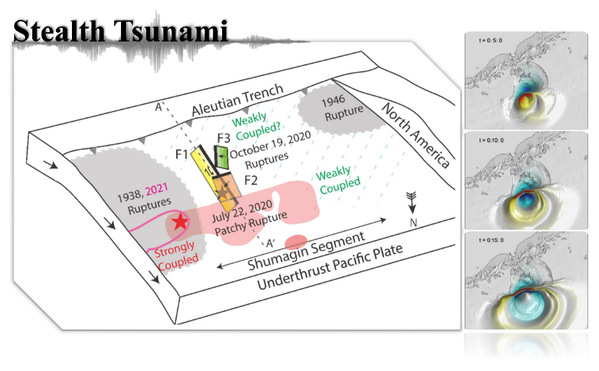Zhejiang University: Complex faulting mechanism triggered stealth tsunami in the 19 October 2020 Magnitude 7.6 Shumagin earthquake
On July 22, 2020, an earthquake with moment magnitude Mw 7.8 occurred off the Shumagin Islands at depths from 25 to 40 km, but no evident tsunami signals were observed from deep-water DART stations offshore Alaska. About three months later, a magnitude Mw 7.6 earthquake struck this region again at depths from 5 to 40 km with aftershocks concentrating within the Pacific plate but straddling the megathrust fault. Long-period seismic moment tensor for the Mw 7.6 event indicated unusual 50° eastward dipping, which was inconsistent with the typical scenario involving large intraplate ruptures seaward of large megathrust events. Adding to the unusual attributes of the October aftershock were stronger tsunamis detected from tide gauges at Alaska, Hawaii, and DART stations. This was surprising because the oblique strike-slip faulting mechanism is intrinsically less efficient in generating tsunamis. The interesting mystery of the October 2020 Mw 7.6 earthquake and tsunami event attracts worldwide attention in academic communities since then but remains unfolded.
A recent study published in Nature Communications on the event reveals an unprecedented level of faulting complexity that resulted in the strong tsunami excitation and a previously unrecognized tsunami hazard. The cross-disciplinary study was collaboratively finished by Prof. BAI Yefei from Zhejiang University, Prof. LIU Chengli from China University of Geosciences, Prof. Thorne Lay from University of California at Santa Cruz, Prof. Kwok Fai Cheung and Prof. Yoshiki Yamazaki from University of Hawaii at Manoa.
Bai et al. analyzed seismic, geodetic, and tsunami observations to quantify the source process accounting for all existing observations. The proposed source model involves rupture of three faults: fast rupture of a dipping strike-slip fault in the Pacific plate, fast rupture of an oblique normal fault in the overriding North American plate, and very slow rupture of a thrust fault striking nearly perpendicular to the trench in the overriding plate that occurred several minutes after the fast faulting. Rupture with large slip thus occurred on faults on either side of the megathrust, which has never been observed in a single event, and the slow thrust rupture occurred near the break in the continental slope with very long slip duration of at least 5 minutes. Its location, geometry and duration make it essentially invisible to the seismic and geodetic data, but it was strongly tsunamigenic.
The findings are of broad interest to the seismic, geodetic, and tsunami modeling communities and has important societal implications for tsunami warning and earthquake hazard for a subduction zone with low geodetic coupling such as the Shumagin seismic gap.

